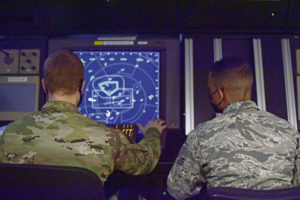
The 86th Operations Support Squadron secures the 86th Airlift Wing rapid mobility and professional airlift mission by maintaining and ensuring the diverse array of capabilities necessary for seamless aircraft movement at Ramstein Air Base.
Comprising more than half of the squadron, the Airfield Operations Flight is responsible for the safe arrival and departure of all 86th AW, transient, exercise and deployed aircraft.
“The AOF is a group of different Air Force Specialty Codes that all come together to expedite the flow of aircraft,” said 1st Lt. Zachary Diehl, 86th OSS airfield operations flight commander.
The flight is divided into three sections: Air Traffic Control, made up of the Tower and Ground Controlled Approach; Airfield Management; and Radar Airfield Weather Systems.
ATC safely and efficiently facilitates the flow of air traffic. Prior to departure, aircraft will communicate with the tower. Once the aircraft is in the sky, pilots will communicate with GCA, who will guide them until they transition to German air traffic controllers.
“We are uniquely certified to be safety advisors for air traffic,” said Staff Sgt. Josh Bailey, 86th OSS air traffic control craftsman. “That’s something that can take a long time to train on, but it’s very important to make sure it is completed thoroughly because we have a very important job of keeping the aircraft safe and keeping things moving quickly.”

When many ATC facilities decreased mission coverage and hours of operation during the COVID-19 pandemic, the Ramstein ATC Tower experienced increased activity. The team quickly adapted to a new manning schedule while maintaining 24/7 operations. They also managed to incorporate personnel from other groups to preserve controlling abilities, a readiness concern GCA applied to pilots, as well.
“We help ensure rules governing flight and practice approaches for the pilots because they need to make sure they stay proficient in all the different types of landings,” said Senior Airman Torey L. Jinks, 86th OSS air traffic controller. “We make sure that they’re still qualified, and when they go downrange, they can land safely.”
Training and readiness play a key role in all aspects of the AOF. Airmen assigned to Airfield Management must be proficient in all aspects of maintaining a safe airfield.
“We ensure that all of the inbound Airmen are trained and qualified correctly,” said Staff Sgt. Tessa Bunn, 86th OSS airfield management and training noncommissioned officer in charge. “We make sure that they can identify any discrepancies while they’re out there doing inspections and checks.”
Airfield Management maintained operational effectiveness during the COVID-19 pandemic, as well. The team fused more than 50 COVID-19 missions with multi-country travel restrictions, limited manning, daily training and transient flight operations, while also teaming with Air Mobility Command, the 86th Medical Group, Landstuhl Regional Medical Center and Transient Alert to execute expeditious support.
In order to execute missions successfully, AOF must have reliable and seamless communication, a capability ensured by RAWS. The section maintains the electrical and mechanical components of the communications between air traffic controllers and aircraft.
In the past, RAWS consisted of airfield systems and radar systems. Airmen of the two career fields are now trained, or are in the process of training, and capable in all systems across the board.
“The benefit of the merger is that you have a more versatile Airman,” said Staff Sgt. Christopher Kenny, 86th OSS RAWS supervisor. “They’re able to go to any base and essentially maintain any radar airfield weather system on that airfield.”
All the processes of the 86th OSS AOF uphold Ramstein’s status as the premiere military logistics hub for Europe, Africa and the Middle East.
“The 86th OSS is a very diverse squadron that has a lot of different career fields,” Diehl said. “There’s intel, weather, aircrew flight equipment… but for me and my flight, we’re just a portion of the squadron — the largest portion, typically. We do what the OSS is meant to do. (We) support operations for the base. That’s the entire purpose of why we’re here; to ensure aircraft depart and arrive safely.”


